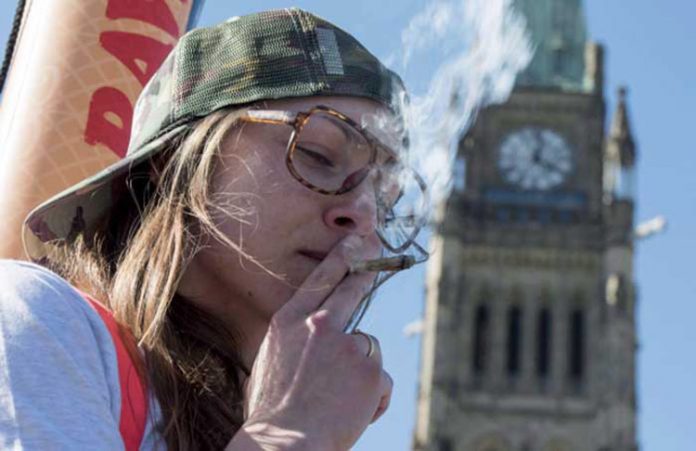“Canadian youth between the ages of 15 and 24 are among the highest users of cannabis in all developed countries.”
Whether making headlines, sprinkled throughout Senate hearings, or tossed around in idle chatter, it’s the one line that is dominating the dialogue on the effect of recreational-cannabis legalization on young Canadians.
Those opposed to Bill C-45, the Cannabis Act, relentlessly abuse the factoid to conjure images of brain-dead teenagers hovering around piles of “high potency” bud, moving on to heroin when the weed fix won’t cut it.
Proponents of legalization, on the other hand, are using it as a cry for help, blowing the whistle on a system that is “clearly not working”.
Jenna Valleriani, who has a PhD in sociology and is a strategic adviser for Canadian Students for Sensible Drug Policy (CSSDP), is concerned that increased penalization, a lack of education strategies, and a disregard for the inclusion of youth voices in the proposed legislation will mean more discrimination for an already vulnerable population.
“We see 18- to 25-year-olds, followed by 12- to 17-year-olds, having the highest number of drug-related arrests, the majority of them for cannabis possession. Criminalization is certainly not working, and we are definitely missing youth experiences,” she told the Straight.
“We really focused on the harms of cannabis and how it ‘can ruin young people’s lives’, but that doesn’t really fit into the context of how young people actually experience their cannabis use. The majority of young people are just using occasionally and experimenting.”
In her presentation to the Standing Senate Committee on Social Affairs, Science and Technology last month, Valleriani noted that of the 25 percent of youths who reported using cannabis during the past year, only 2.5 percent reported using in ways considered high-risk for severe health problems—a fact, she says, often ignored in discussions of prevention and harm reduction.
Although the legislation will allow Canadians aged 12 to 17 to possess up to five grams of cannabis before facing criminal charges, some provinces, like Ontario, are opting for a zero-tolerance policy. Police officers and judges will have discretion when it comes to enforcing the new laws, which, Valleriani cautioned, will open the door to discrimination against youths already marginalized by things like economic status and race.
Scott Bernstein, a lawyer and senior policy analyst with the Canadian Drug Policy Coalition, says the people already disproportionately targeted for cannabis-related arrests come from racialized and marginalized communities, and the new laws are likely to make matters worse.
“Right now, the biggest harm from cannabis to youth…is not the fact that they are using it but the fact that they are being criminalized for it,” he said.
Bernstein said layering on more restrictions is only going to aggravate an already contentious problem, while a “softer approach”, like an administrative penalty, would be better suited to the government’s mandate of protecting young people.
“People need to understand that the hammer of criminal justice on young people is the most serious thing that can happen,” he said, adding that in many cases, criminal records follow youths into their adult years, preventing them from travelling and working.
Treating it like a traffic ticket instead, he suggested, acknowledges that someone broke the law and creates a penalty but eliminates the long-lasting harm of a criminal offence.
“We need to go to the fact that we are not inventing cannabis now. We don’t have to be afraid that people will start smoking cannabis, because they already are,” Bernstein said, adding that education would likely have a better outcome in reducing youth drug abuse.
In April, the CSSDP published the Sensible Cannabis Toolkit, an evidence-based educational resource for parents and teachers that outlines 10 principles for a new type of drug education. Valleriani, who worked on the project, said informed and nonjudgmental conversations are the real first steps to harm reduction and prevention postlegalization.
“What they [youths] really want is a centralized, evidence-based place that they can access information,” she said, adding that youths want to be involved in the creation of these types of resources.
“Lecture-style conversations around drugs are not very effective. What is really interesting is once you start talking to young people about their cannabis use, they are so open about it but don’t have the avenues very often to talk with adults about cannabis.”
One Toronto-based children’s charity has already developed a fresh approach to drug education based on neutrality and inclusion.
Danielle Sutherland, the curriculum-development manager at Skylark Children, Youth and Families, has worked with more than 300 children and teens. She said the old system of shaming, essentially scare tactics, isn’t working with kids anymore. Sessions, a Skylark youth program, invites participants to engage in creative activities and lead group projects to foster an informed dialogue.
“We came up with a model called integrative resilience. We build relationships with our youth through education and trust, and we’re finding that it has much better results than other drug-education programs,” Sutherland said.
“If we can have the knowledge come from the young people in the room, through them asking the questions or driving the conversation, they’re more likely to question their own decisions and make positive choices when it comes to cannabis use.”














